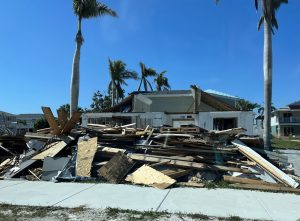Congress holds hearing in Ft. Myers

A home in Ft. Myers Beach awaits repairs from Hurricane Ian damage, June 27, 2023
A U.S. House of Representatives Oversight subcommittee held a televised field hearing in Fort Myers on August 10 and heard what worked and what could have been done better in the federal response to last September’s Hurricane Ian – the costliest hurricane in Florida history and third costliest in the U.S. Some of the testimony from local, state, and federal officials mirror recommendations in a new report out by the Brookings Institution.
Lee County Commissioner Brian Hamman’s comments were representative of the hearing. He praised the federal agencies for their quick response with disaster assistance teams and recovery centers, but complained they were slow to provide enough communication resources, inspectors, and travel trailers, and that FEMA clashed with local officials on occasion. SBA and HUD were slow to dispense money, he added.
“There were many moments across many different agencies where the regulatory hurdles, miscommunication, and burdensome administrative requirements were too big and too rigid to meet the community’s needs. What was needed at that time was urgency and flexibility,” Hamman said.
FEMA’s coordinator for Ian relief, Thomas McCool, acknowledged it took 45 days between approval of mobile housing for each resident and the trailers’ arrival, but said transitional shelter was available in hotels, even if it was spread across three states, addressing another complaint at the hearing. McCool, in response to Florida Congressman Byron Donalds’ question why it took 45 days, said FEMA isn’t allowed to place trailers in special flood hazard areas, such as the barrier islands, out of concern for residents’ safety. It eventually did, he said, “after intense coordination with local building officials and floodplain managers.” Of the 1,335 trailers FEMA placed in the region, 533 were in flood zones.
They also discussed the community development block grants program to repair infrastructure, with a HUD official admitting it can take a year and a half for money to flow following a disaster, something the agency is looking to speed up. The politicians at the hearing admitted Congress shares responsibility for flaws in the current disaster relief process.
As of the latest mid-March FEMA report, the federal government has spent nearly $7 billion on Ian recovery to help Floridians with rent, repair, temporary housing, and flood insurance payments and to help the state of Florida with debris removal and other emergency response and recovery costs. That includes over $3.9 billion to more than 48,000 National Flood Insurance Program policyholders.
You can read much more from the Florida Phoenix and watch the full hearing on C-SPAN here.
 Brookings Report: The Brookings Institution is out with the second in its series of reports on reforming national disaster policy. The report, The U.S. Needs a New System for Declaring Natural Disasters and Distributing Federal Aid makes a series of recommendations, mostly addressed at FEMA. The report says that FEMA’s “determinations of eligibility for federal resources and the amount given should be based not just on property damage estimates, but other metrics that capture social vulnerability,” just as HUD relief does. This could include loss of affordable housing, impact on low-income and very low-income households, and impacts on populations with additional needs, such as the elderly or disabled.
Brookings Report: The Brookings Institution is out with the second in its series of reports on reforming national disaster policy. The report, The U.S. Needs a New System for Declaring Natural Disasters and Distributing Federal Aid makes a series of recommendations, mostly addressed at FEMA. The report says that FEMA’s “determinations of eligibility for federal resources and the amount given should be based not just on property damage estimates, but other metrics that capture social vulnerability,” just as HUD relief does. This could include loss of affordable housing, impact on low-income and very low-income households, and impacts on populations with additional needs, such as the elderly or disabled.
Another recommendation is a unified federal disaster application process, in which households submit their information once, their damage and need is assessed and documented, and all federal agencies reference the same documentation to determine eligibility and distribute resources. Brookings says that a universal application would allow households to receive information about the whole set of resources available and make decisions accordingly.
LMA Newsletter of 8-21-23

